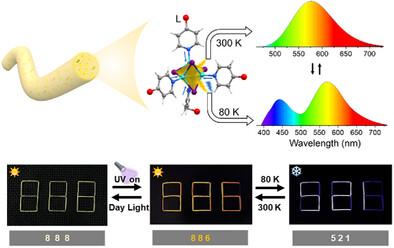嵌入热响应性碘化铜簇的超稳定发光智能纺织品
IF 12.1
2区 材料科学
Q1 CHEMISTRY, MULTIDISCIPLINARY
引用次数: 0
摘要
由于其结构通用性和优异的光致发光(PL)性能,碘化铜簇已成为柔性光电器件的有前途的候选者,但其实际应用受到机械脆弱性和环境稳定性不足的阻碍。本文提出了一种可扩展的湿纺丝策略来制备超稳定Cu4I4(L)4@CA纤维(L1 = 4‐苄基吡啶;L2 = 4‐叔丁基吡啶;CA =海藻酸钙)。分子包封在超低掺杂1 wt%的情况下保持了高的光致发光量子产率(PLQYs >85%),同时实现了完全可逆的热致变色开关:在80-300 K范围内从白色到黄色(L1)和从蓝紫色到橙色(L2)的转变。纤维具有纺织品级的柔韧性和超高的环境稳定性(在湿度/紫外线/溶剂下保持98%的PL)。利用这些特性,开创了双认证加密平台,具有三态信息交换(环境,紫外线和低温状态)和DNA启发的二进制光子编码,使用可编程的Y /十字形喷丝器进行数据转录。通过协调刺激响应光电子技术与纺织品可加工性,本研究为下一代安全可穿戴设备、隐身发光纺织品和分层防伪系统建立了一个协同材料平台。本文章由计算机程序翻译,如有差异,请以英文原文为准。

Ultra‐Stable Luminescent Smart Textiles Embedded With Thermally Responsive Copper Iodide Clusters
Copper iodide clusters have emerged as a promising candidate for flexible optoelectronic devices due to their structural versatility and exceptional photoluminescence (PL) properties, yet their practical application is hindered by insufficient mechanical fragility and environmental stability. Herein, a scalable wet‐spinning strategy is presented to fabricate ultrastable Cu4 I4 (L)4 @CA fibers (L1 = 4‐benzylpyridine; L2 = 4‐tert‐butylpyridine; CA = calcium alginate). The molecular encapsulation preserves high photoluminescence quantum yields (PLQYs >85%) at an ultralow 1 wt% doping while enabling fully reversible thermochromic switching: white to yellow (L1 ) and blue–purple to orange (L2 ) transitions across 80–300 K. The fibers demonstrate textile‐grade flexibility and ultrahigh environmental stability (>98% PL retention under humidity/UV/solvents). Leveraging these properties, a dual‐authentication encryption platform is pioneered featuring triple‐state information switching (ambient, UV, and cryogenic states) and DNA‐inspired binary photonic encoding using programmable Y‐/cross‐shaped spinnerets for data transcription. By harmonizing stimuli‐responsive optoelectronics with textile processability, this work establishes a synergistic material platform for next‐generation secure wearables, stealth luminescent textiles, and hierarchical anti‐counterfeiting systems.
求助全文
通过发布文献求助,成功后即可免费获取论文全文。
去求助
来源期刊

Small
工程技术-材料科学:综合
CiteScore
17.70
自引率
3.80%
发文量
1830
审稿时长
2.1 months
期刊介绍:
Small serves as an exceptional platform for both experimental and theoretical studies in fundamental and applied interdisciplinary research at the nano- and microscale. The journal offers a compelling mix of peer-reviewed Research Articles, Reviews, Perspectives, and Comments.
With a remarkable 2022 Journal Impact Factor of 13.3 (Journal Citation Reports from Clarivate Analytics, 2023), Small remains among the top multidisciplinary journals, covering a wide range of topics at the interface of materials science, chemistry, physics, engineering, medicine, and biology.
Small's readership includes biochemists, biologists, biomedical scientists, chemists, engineers, information technologists, materials scientists, physicists, and theoreticians alike.
 求助内容:
求助内容: 应助结果提醒方式:
应助结果提醒方式:


